This easy homemade bagels recipe proves that you can make deliciously chewy bagels in your own kitchen with only a few basic ingredients and baking tools!
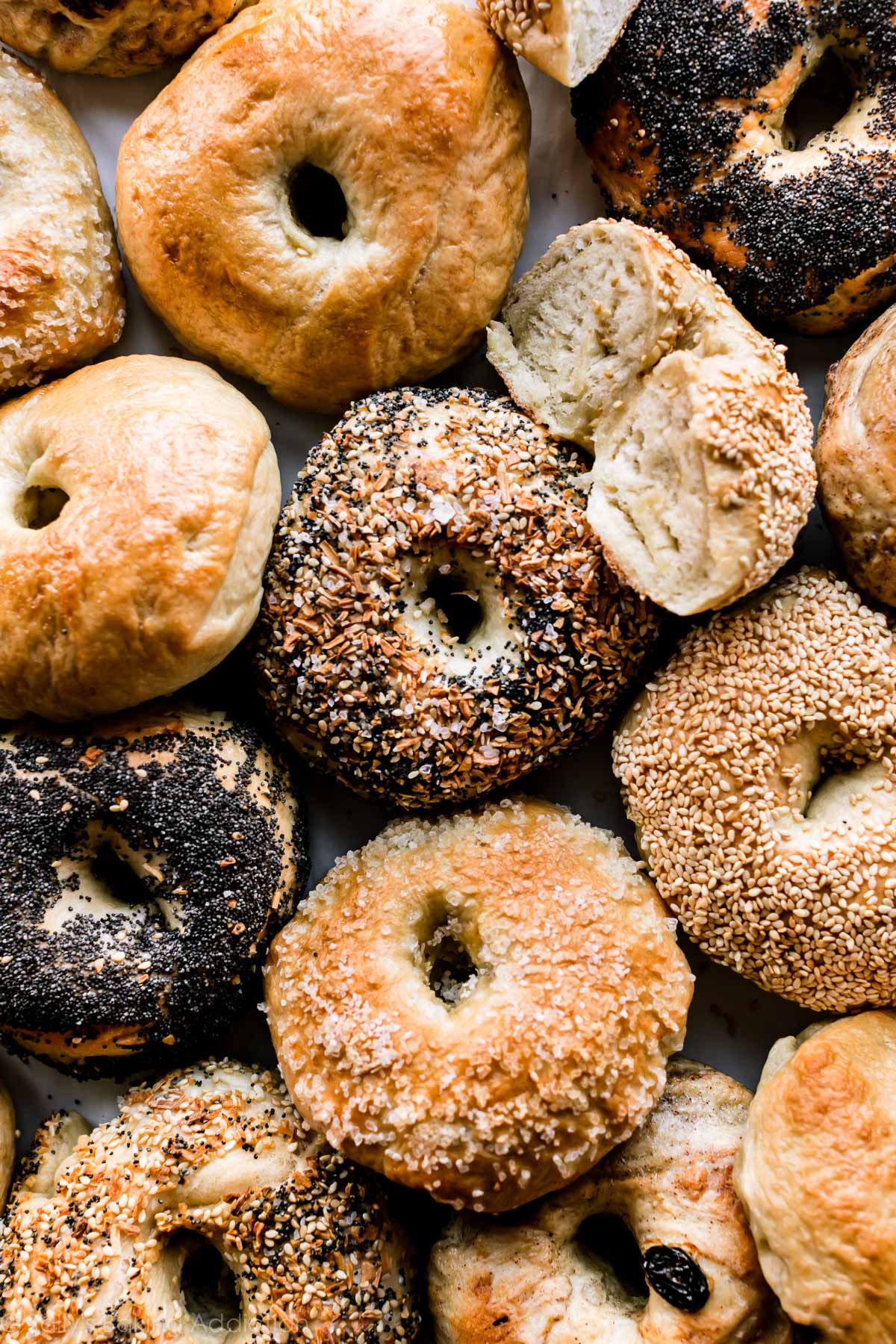
Today I’m teaching you how to make homemade bagels with only a few basic ingredients and kitchen tools. Today you’re going to tackle any fears of yeast and bread baking—and I’m right here to guide you along!
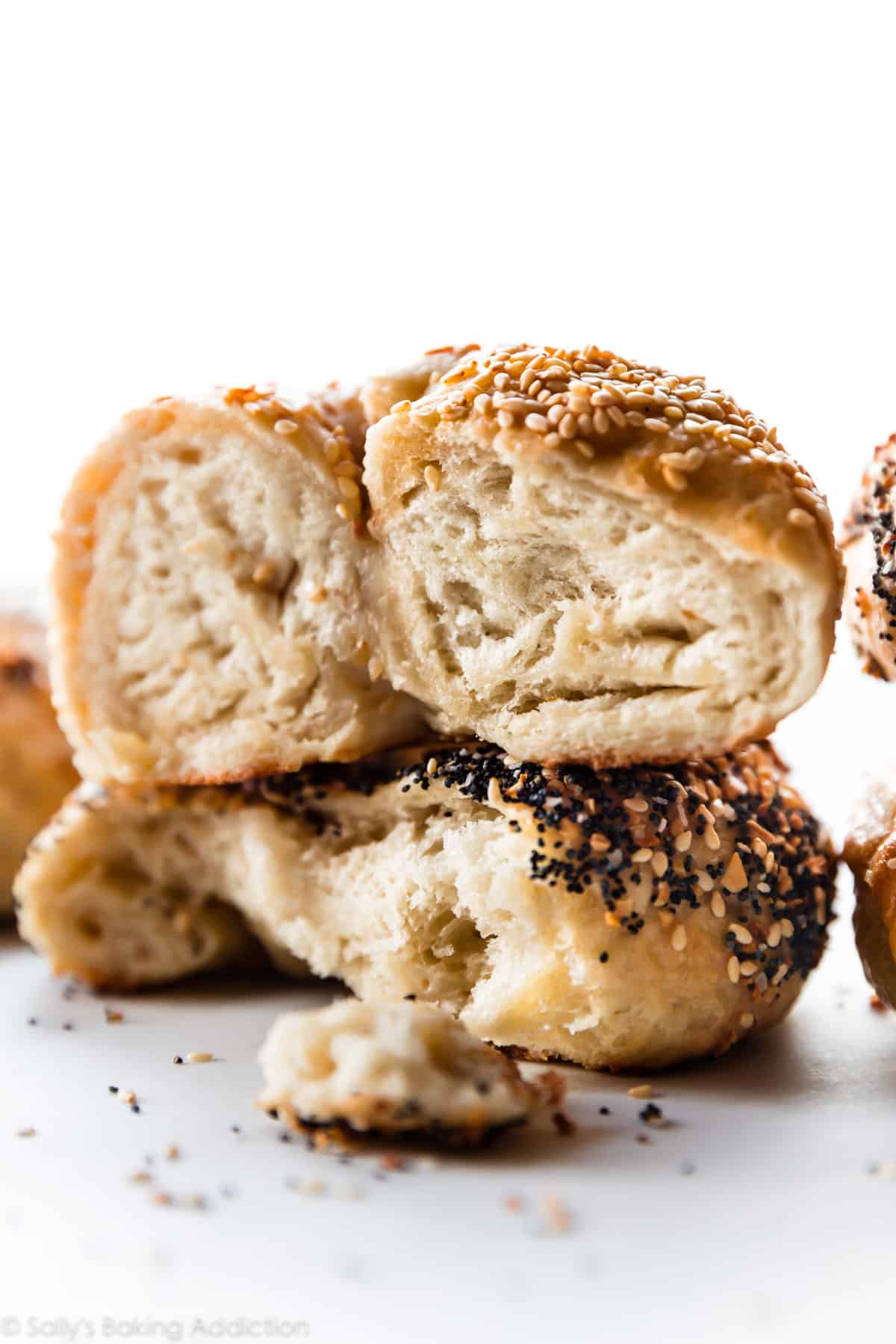
Bagels, crème brûlée, soft pretzels, and French macarons. What do these foods have in common? Each seem really complicated to make at home. That’s why you’ll often find them on your baking bucket list. But secretly, they couldn’t be easier. Homemade bagels taste fresher, are cheaper, and you’ll earn the bragging rights for from-scratch baking. (PS: Each of those recipes has a video tutorial!)
Bagels Require a Lean Dough
The 1st step is to make the bagel dough. This is the same dough you use for everything bagels, a recipe already published on my blog. There’s only 5 ingredients.
- Warm Water: Liquid for the dough.
- Yeast: Allows the dough to rise. I recommend an instant or active dry yeast.
- Bread Flour: A high protein flour is necessary for bagels. We want a dense and chewy texture, not soft and airy like cinnamon rolls. Bread flour is the only solution!
- Brown Sugar: Bakeries use barley malt syrup to sweeten the bagel dough—it can be a little difficult to find, but brown sugar is a fine substitute.
- Salt: Flavor.
Notice how there is no fat? This is called a lean dough. Lean dough is ideal for recipes like focaccia, pizza dough, artisan bread, and cranberry nut no-knead bread. Breads like dinner rolls and homemade breadsticks, and sweet bread, such as cinnamon rolls, include fat for richness and flavor.
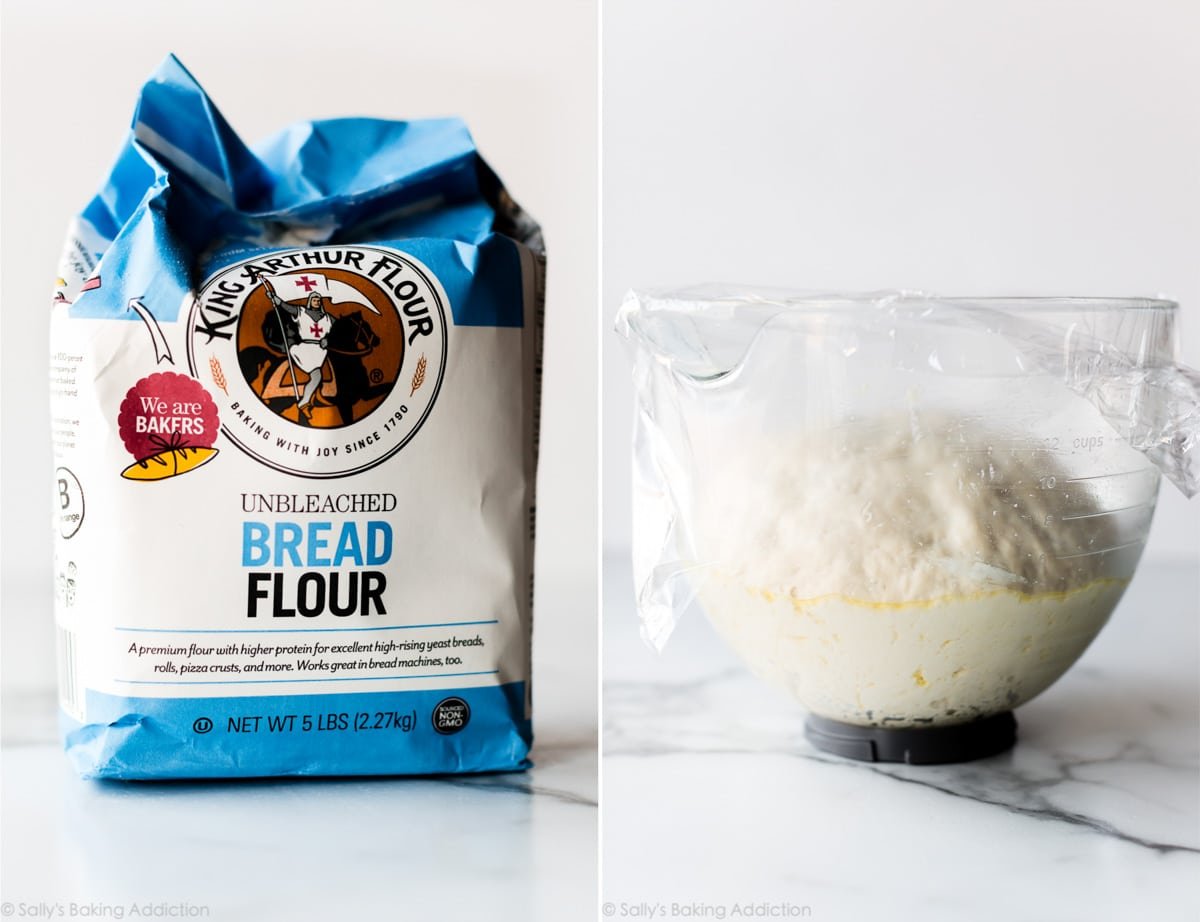
You can prepare and knead the dough with a mixer or by hand. If you’d like a visual of how to knead the dough by hand, you can watch the full video tutorial in my post on How To Knead Dough. After the dough has been kneaded, let it rise for 60-90 minutes. Punch it down, then divide into 8 sections and shape into bagels.
How to Shape Bagels
Shaping bagels is easier than it looks. Poke your finger through the center of the ball of dough, then use 2 fingers to widen the hole to about 1.5 – 2 inches. That’s it! I don’t really do anything fancy and the bagels don’t need to be perfect. Mine never are!
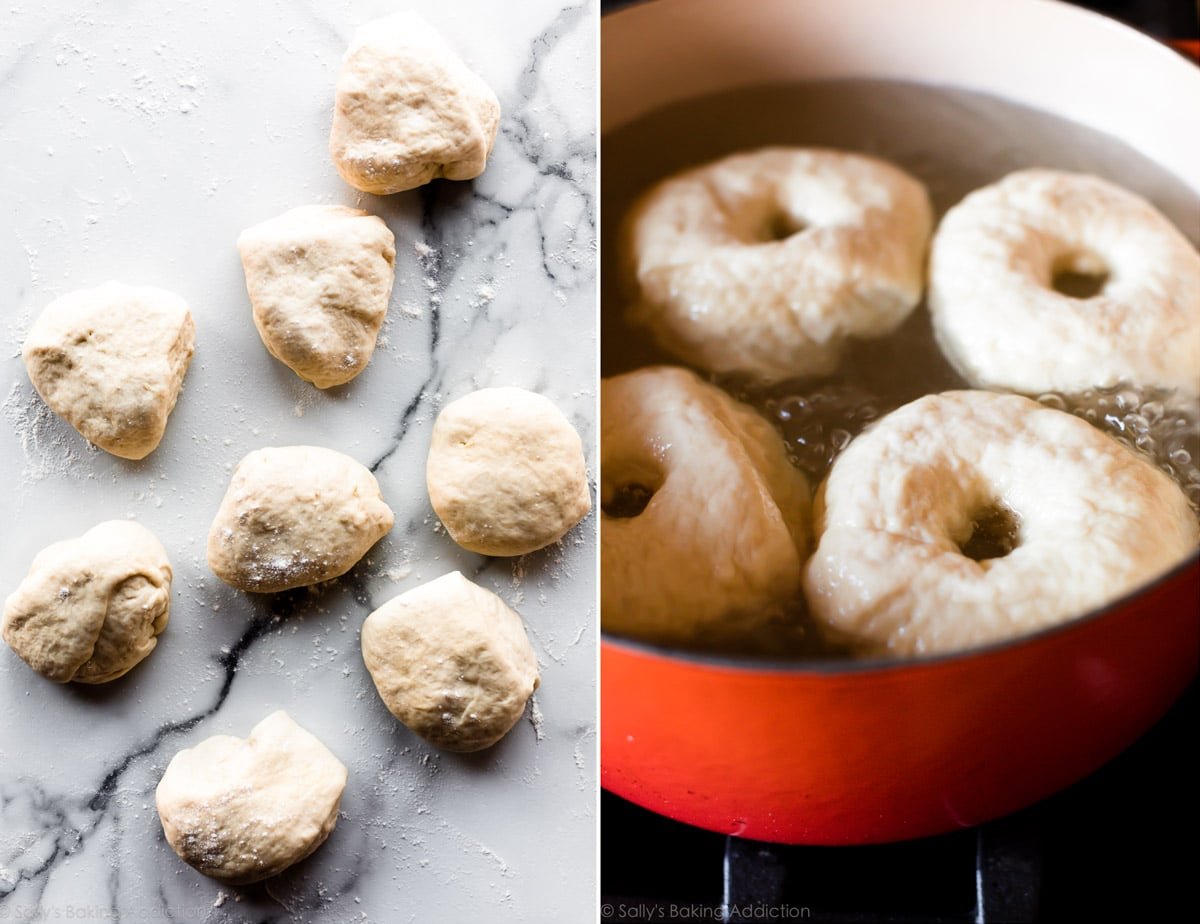
Bagel Water Bath
Bagels must cook for 1 minute on each side in a pot of boiling water. This is actually the most important step in the whole recipe. Why?
- Boiling the bagels gives the bagel its beautiful shine. But looks aren’t everything—this shine is actually a result of the dough’s starches gelatinizing which creates a crisp, shiny coating. I learned this from Cooks Illustrated.
- Boiling bagels cooks the outer layer of dough, which guarantees they’ll hold their shape in the oven.
Add honey or barley malt syrup to the water bath. Why? The sugar adds extra caramelization and crisp. Brushing the boiled bagels with egg wash does the same. Don’t skip either!
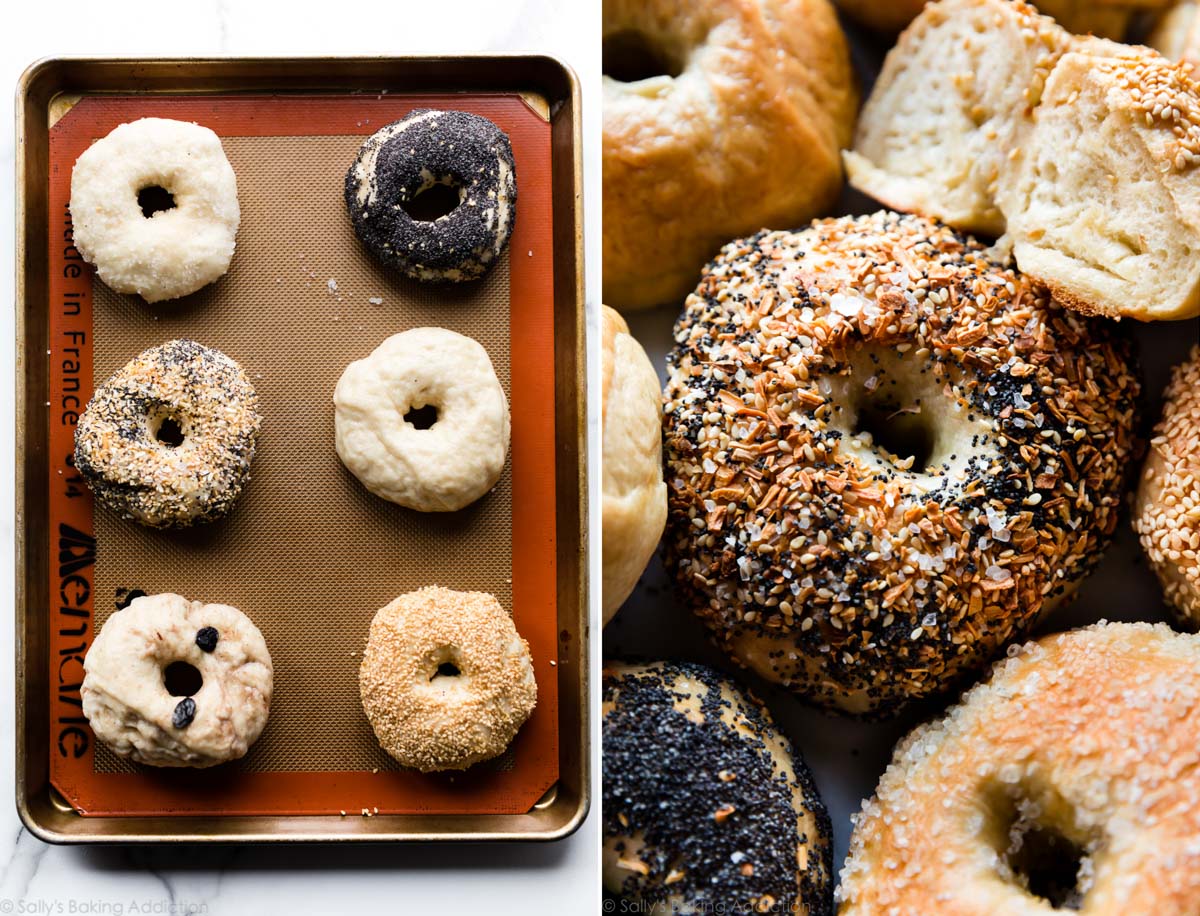
Homemade Bagel Varieties
- Plain Bagels: Follow the recipe below. These are excellent as the base for breakfast casserole.
- Cinnamon Raisin Bagels: Follow my cinnamon raisin bagels recipe.
- Everything Bagels: Follow my everything bagels recipe.
- Sesame Seed Bagels: Use 1/3 cup sesame seeds. After brushing with egg wash in step 9, top with or dunk each bagel into topping. Use more as needed.
- Poppy Seed Bagels: Use 1/3 cup poppy seeds. After brushing with egg wash in step 9, top with or dunk each bagel into topping. Use more as needed.
- Salt Bagels: Use 1/3 cup coarse sea salt. After brushing with egg wash in step 9, top with or dunk each bagel into topping. These are pretty salty, so feel free to go lighter on the salt.
- Cheese Bagels (Asiago, Cheddar, etc): Add 1/2 cup of shredded cheese to the dough when you add the flour. After brushing with egg wash in step 9, sprinkle with extra cheese.
- Cinnamon Crunch Bagels: Add 1 teaspoon of cinnamon to the dough recipe below when you add the salt. Double the cinnamon crunch topping from cinnamon crunch bread. After brushing the bagels with the egg wash in step 9 below, spoon cinnamon crunch topping on each.
Some readers have used this bagel recipe to make whole wheat bagels by replacing half of the bread flour with whole wheat flour. I haven’t tried it, but I do use some whole wheat flour when making homemade English muffins, another breakfast staple!
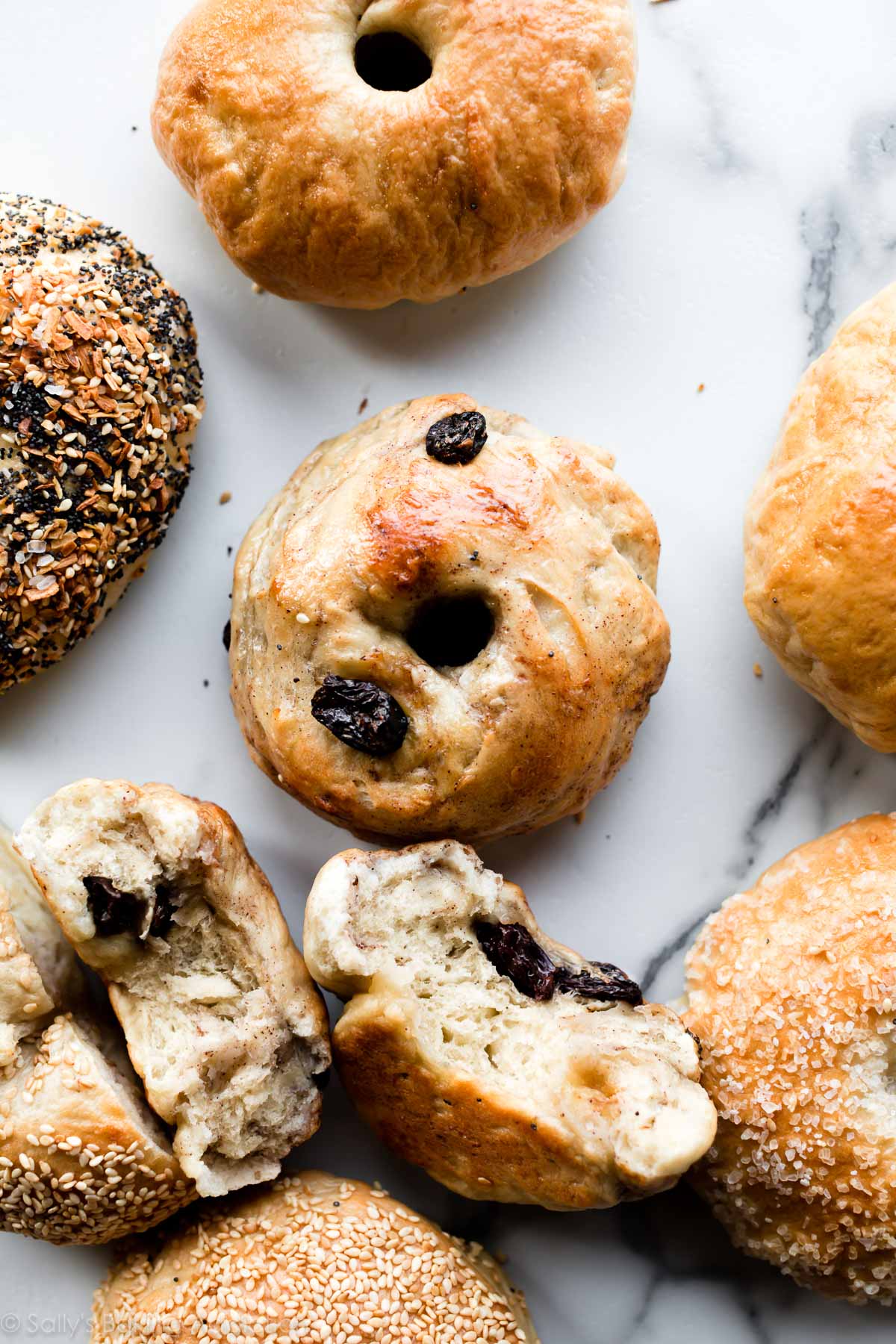
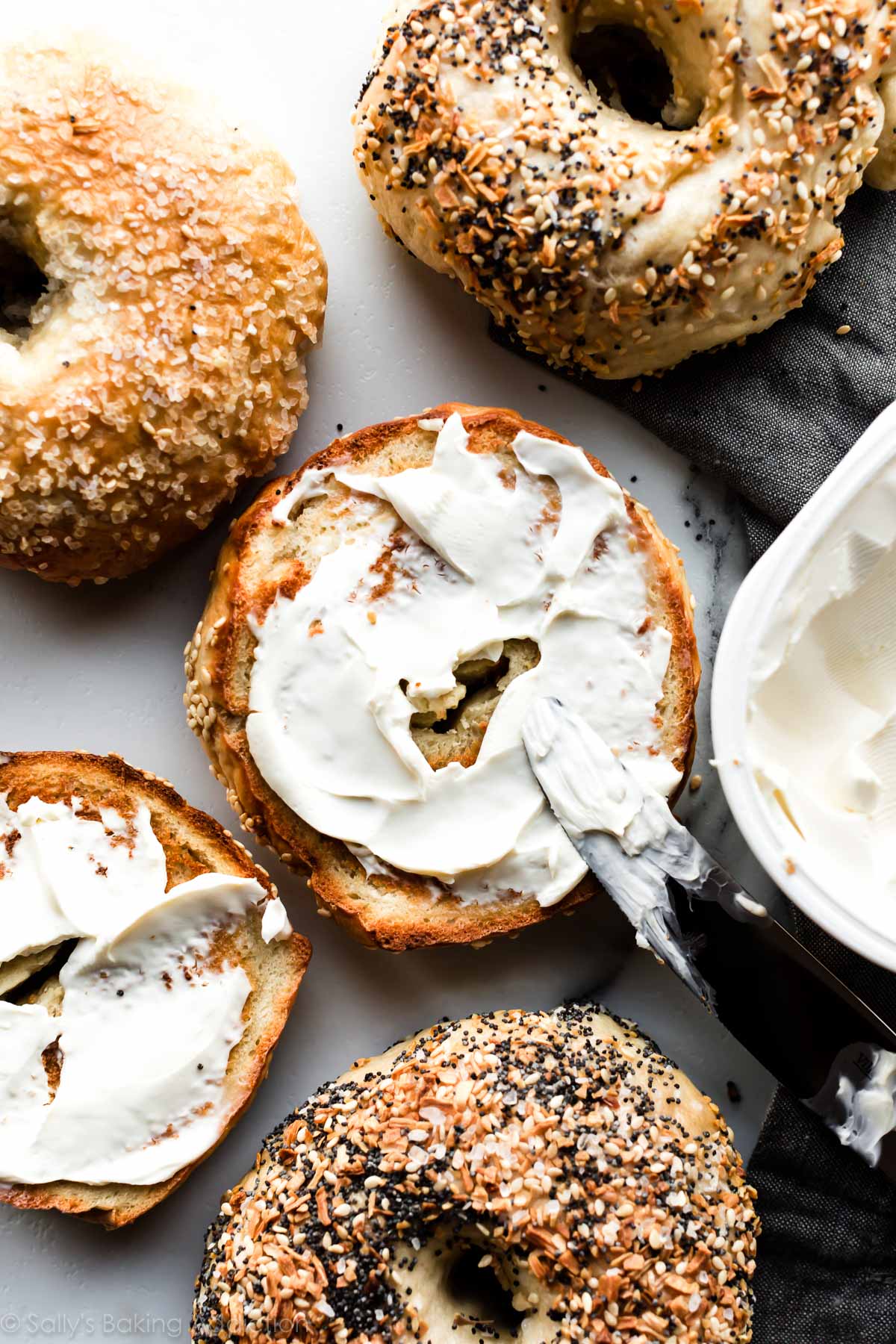
See Your Homemade Bagels!
Many readers tried this recipe as part of a baking challenge! Feel free to email or share your recipe photos with us on social media. 🙂
Print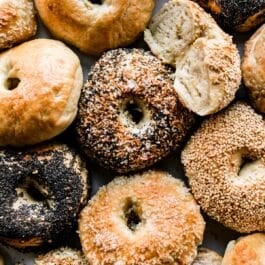
Homemade Bagels Recipe
- Prep Time: 2 hours, 10 minutes
- Cook Time: 25 minutes
- Total Time: 3 hours
- Yield: 8 bagels
- Category: Bread
- Method: Baking
- Cuisine: American
Description
Make fresh bagels right at home with this tested dough recipe. Don’t skip the water bath and egg wash—both provide an extra chewy and golden brown crust.
Ingredients
- 1 and 1/2 cups (360ml) warm water (between 100-110°F, 38-43°C)
- 2 and 3/4 teaspoons instant or active dry yeast*
- 4 cups (520g) bread flour (spooned & leveled), plus more for work surface and hands*
- 1 Tablespoon granulated sugar or packed light or dark brown sugar (or barley malt syrup)*
- 2 teaspoons salt
- coating the bowl: nonstick spray or 2 teaspoons olive oil
- egg wash: 1 egg white beaten with 1 Tablespoon water
For Boiling
- 2 quarts water
- 1/4 cup (60g) honey (or barley malt syrup)*
Instructions
- Prepare the dough: Whisk the warm water and yeast together in the bowl of your stand mixer fitted with a dough hook attachment. Cover and allow to sit for 5 minutes. *If you don’t have a stand mixer, simply use a large mixing bowl and mix the dough with a wooden spoon or silicone spatula in the next step.
- Add the flour, brown sugar, and salt. Beat on low speed for 2 minutes. The dough is very stiff and will look somewhat dry.
- Knead the dough: Keep the dough in the mixer and beat for an additional 6-7 full minutes, or knead by hand on a lightly floured surface for 6-7 full minutes. (If you’re new to bread-baking, my How to Knead Dough video tutorial can help here.) If the dough becomes too sticky during the kneading process, sprinkle 1 teaspoon of flour at a time on the dough or on the work surface/in the bowl to make a soft, slightly tacky dough. Do not add more flour than you need because you do not want a dry dough. After kneading, the dough should still feel a little soft. Poke it with your finger—if it slowly bounces back, your dough is ready to rise. You can also do a “windowpane test” to see if your dough has been kneaded long enough: tear off a small (roughly golfball-size) piece of dough and gently stretch it out until it’s thin enough for light to pass through it. Hold it up to a window or light. Does light pass through the stretched dough without the dough tearing first? If so, your dough has been kneaded long enough and is ready to rise. If not, keep kneading until it passes the windowpane test.
- Lightly grease a large bowl with oil or nonstick spray. Place the dough in the bowl, turning it to coat all sides in the oil. Cover the bowl with aluminum foil, plastic wrap, or a clean kitchen towel. Allow the dough to rise at room temperature for 60-90 minutes or until double in size.
- Line two large baking sheets with parchment paper or silicone baking mats.
- Shape the bagels: When the dough is ready, punch it down to release any air bubbles. Divide the dough into 8 equal pieces. (Just eyeball it—doesn’t need to be perfect!) Shape each piece into a ball. Press your index finger through the center of each ball to make a hole about 1.5 – 2 inches in diameter. Watch video below for a visual. Loosely cover the shaped bagels with kitchen towel and rest for a few minutes as you prepare the water bath.
- Preheat oven to 425°F (218°C).
- Water bath: Fill a large, wide pot with 2 quarts of water. Whisk in the honey. Bring water to a boil, then reduce heat to medium-high. Drop bagels in, 2-4 at a time, making sure they have enough room to float around. Cook the bagels for 1 minute on each side.
- Using a pastry brush, brush the egg wash on top and around the sides of each bagel. Place 4 bagels onto each lined baking sheet.
- Bake for 20-25 minutes, rotating the pan halfway through. You want the bagels to be a dark golden brown. Remove from the oven and allow bagels to cool on the baking sheets for 20 minutes, then transfer to a wire rack to cool completely.
- Slice, toast, top, whatever you want! Cover leftover bagels tightly and store at room temperature for a few days or in the refrigerator for up to 1 week.
Notes
- Overnight Make Ahead Instructions: Prepare the dough through step 4, but allow the dough to rise overnight in the refrigerator instead of at room temperature for 60-90 minutes. The slow rise gives the bagels wonderful flavor! In the morning, remove the dough from the refrigerator and let the dough rise for 45 minutes at room temperature. Continue with step 5. I don’t recommend shaping the bagels the night before as they may puff up too much overnight.
- Freezing Make Ahead Instructions: Baked bagels freeze wonderfully! Freeze them for up to 3 months, thaw overnight in the refrigerator or at room temperature, then warm to your liking. You can also freeze the bagel dough. After punching down the dough in step 6, wrap the dough tightly in plastic wrap, then a layer of aluminum foil. Freeze for up to 3 months. Thaw overnight in the refrigerator, then punch the dough down again to release any air bubbles. Continue with the rest of step 6.
- Special Tools (affiliate links): Stand Mixer | Baking Sheets | Parchment Paper or Silicone Baking Mats | Large Pot (such as a large 5.5 quart dutch oven) | Pastry Brush
- Yeast: Use instant or active dry yeast. If using active dry yeast, the rise time may be up to 2 hours. 1 standard packet is about 2 and 1/4 teaspoons, so you will need a little more than 1 packet of yeast. Reference my Baking with Yeast Guide for answers to common yeast FAQs.
- Bread Flour: Bagels require a high protein flour. Bread flour is a must. Here are all my recipes using bread flour if you want more recipes to use it up. All-purpose flour can be used in a pinch, but the bagels will taste flimsy and won’t be nearly as chewy.
- Barley Malt Syrup: This ingredient can be a little hard to find, but truly gives bagels that traditional malty flavor we all know and love. Most natural food stores carry it. I offer alternatives such as brown sugar in the dough and honey in the water bath; I’ve made bagels with these alternatives AND with barley malt syrup and honestly love both versions.
- Bread Machine: Place the dough ingredients into the pan of the machine. Program the machine to dough or manual, then start. After 9-10 minutes, the dough will be quite stiff. Allow the machine to complete its cycle, then continue with the recipe.
- Bagel Varieties: See blog post above for various add-ins and toppings. Note that the toppings are added after the egg wash in step 9. Some readers have used this bagel recipe to make whole wheat bagels by replacing half of the bread flour with whole wheat flour. I haven’t tried it, but let me know if you do!
- Halve or Double: You can halve this dough recipe by simply halving all of the dough ingredients (do not halve the water or honey for the boiling step). No changes to the recipe instructions. For best taste and texture and to not overwhelm your mixer with excess heavy dough, I do not recommend doubling this dough recipe. Instead, make separate batches of dough.
- Adapted from a mix of recipes I’ve tried: King Arthur Flour, Cook’s Illustrated, and Complete Book of Breads
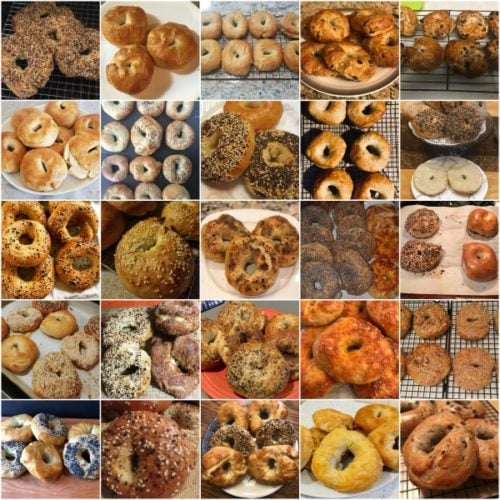
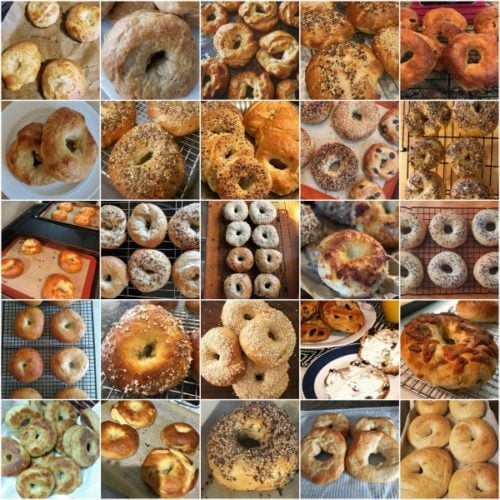
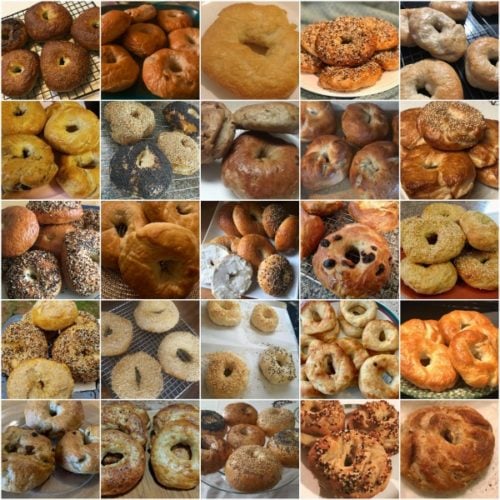
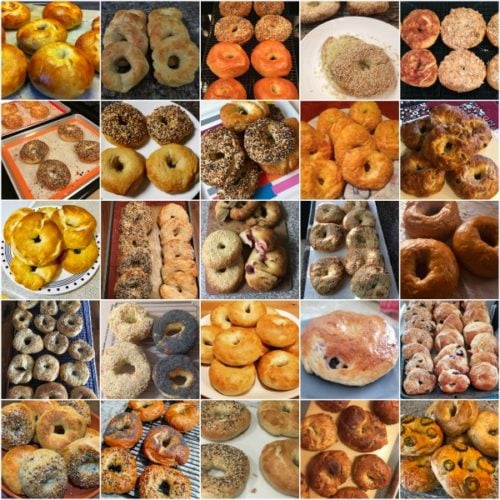
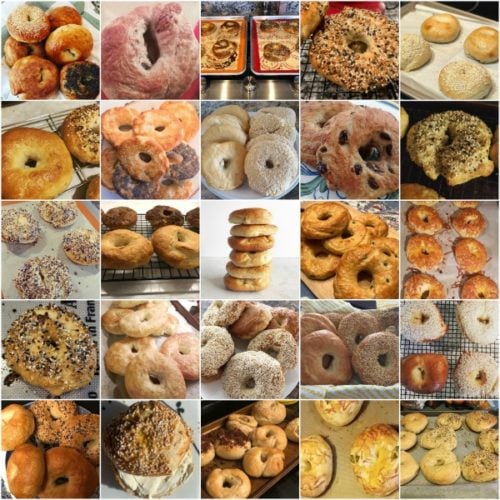

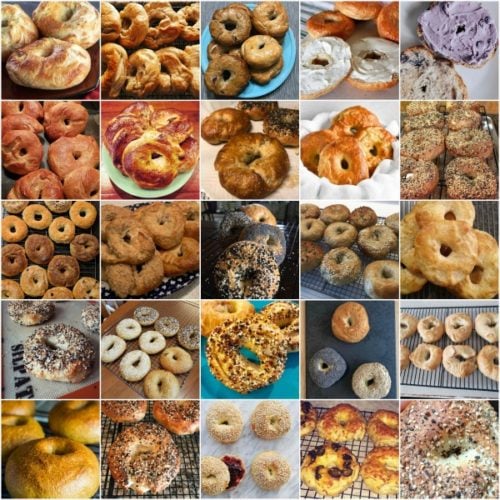
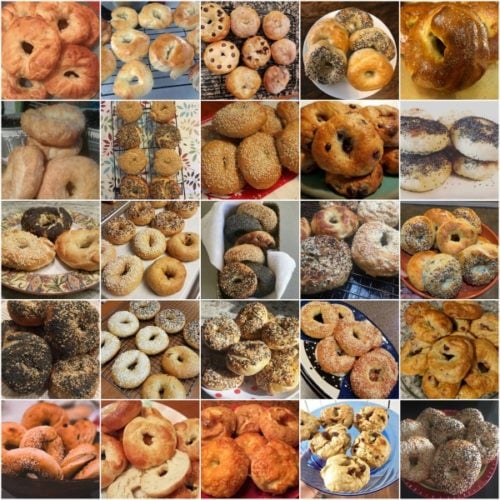
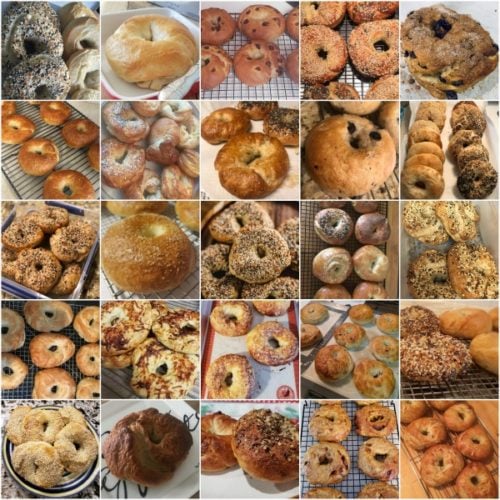
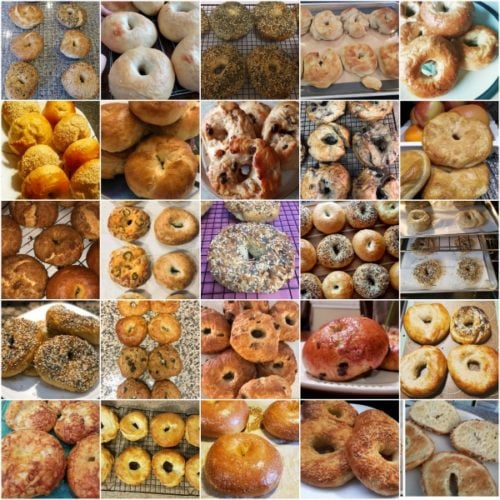
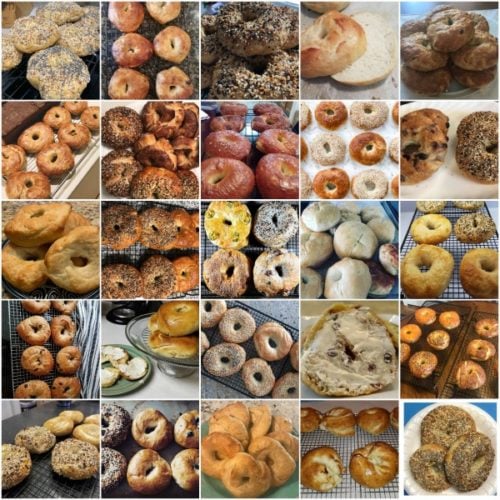
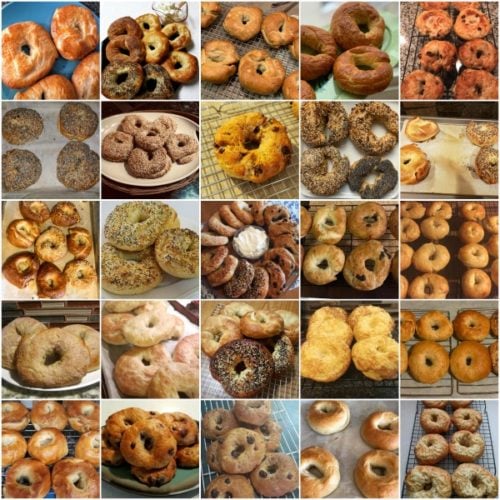
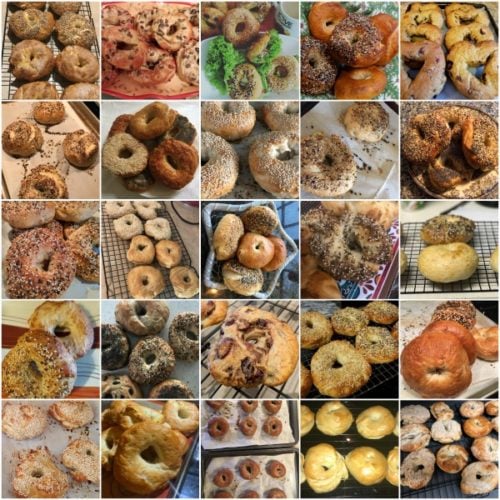
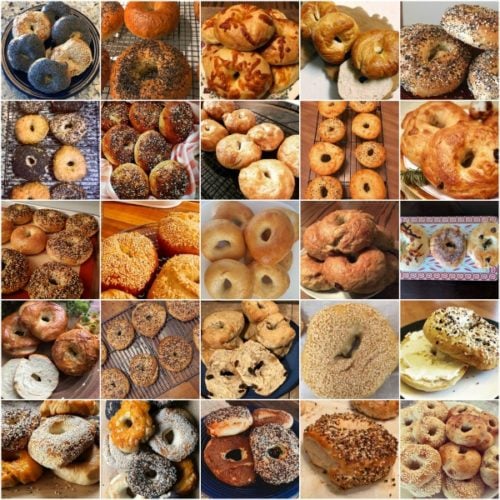
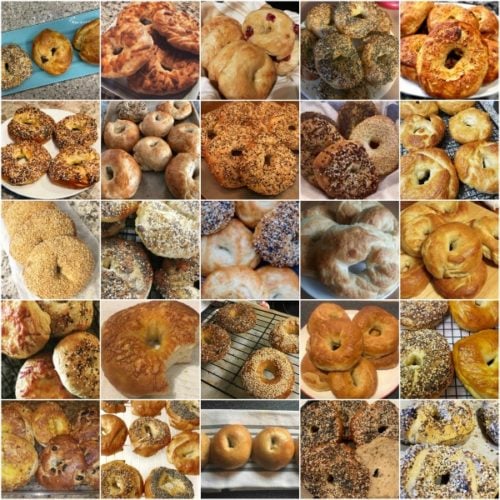
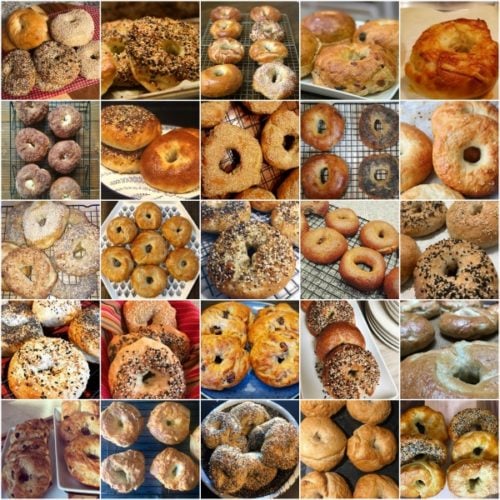
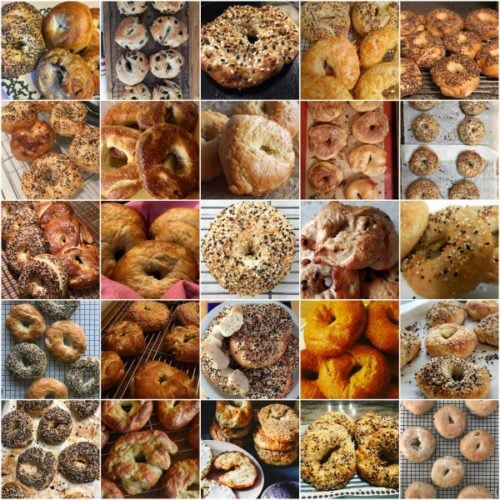
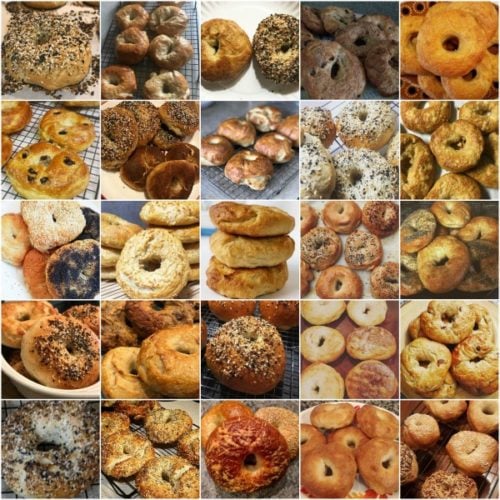
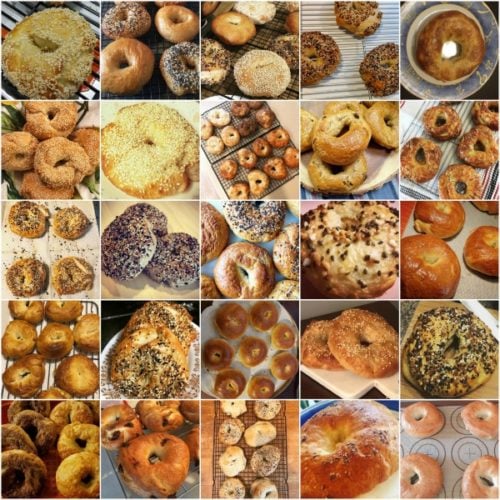
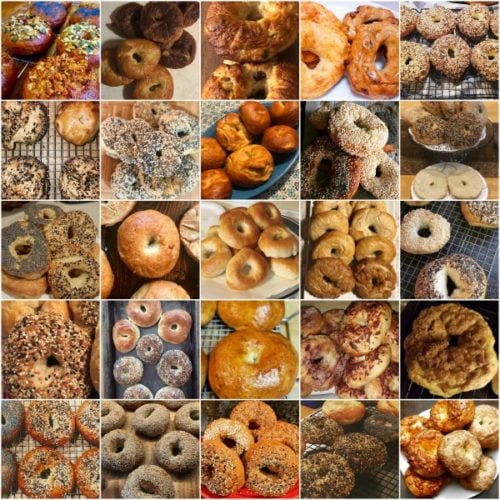
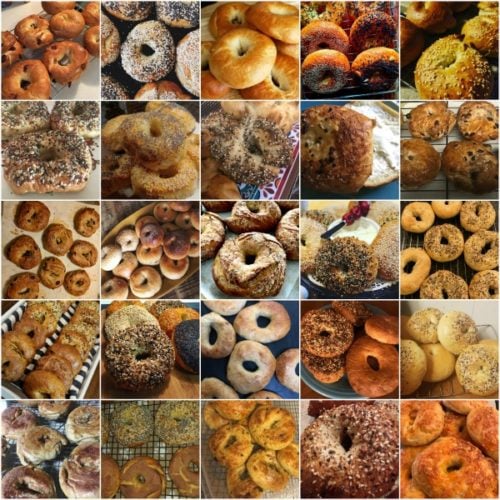
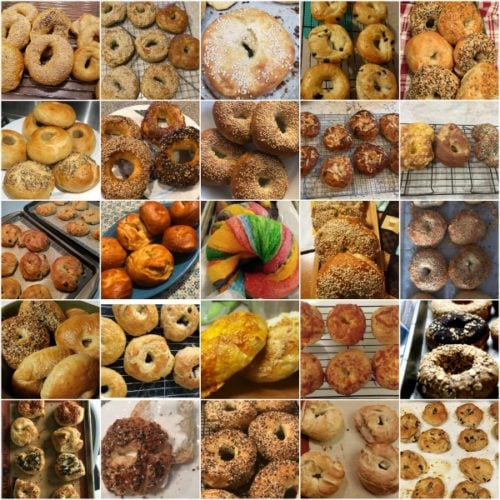
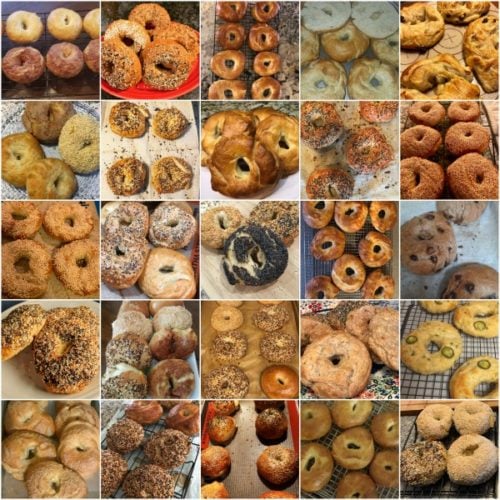
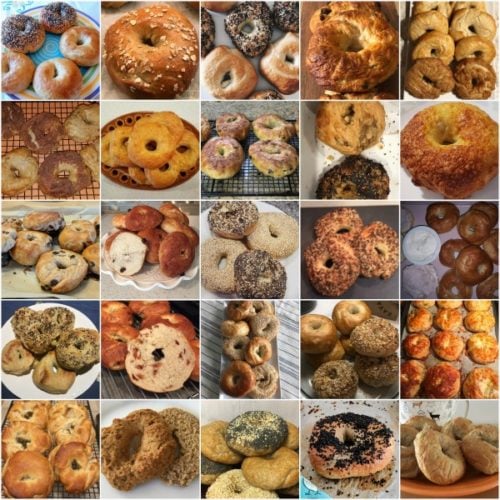
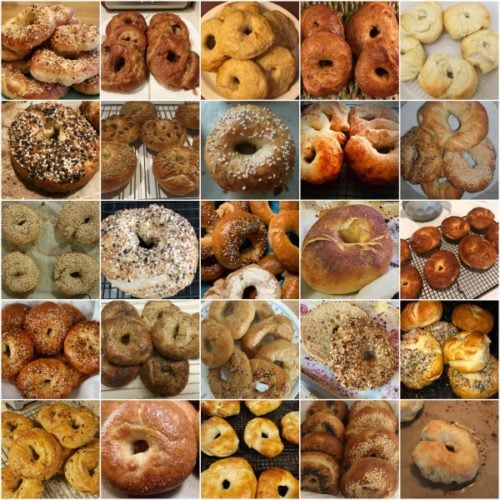
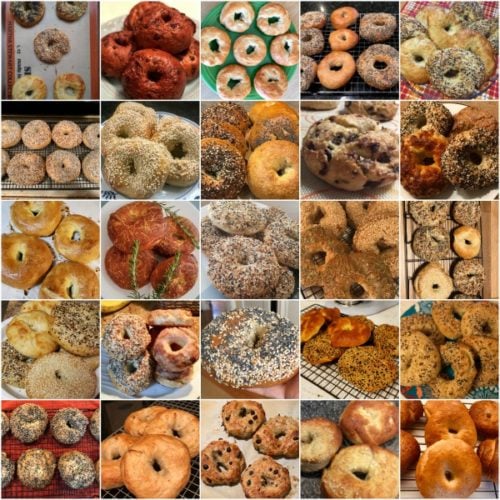

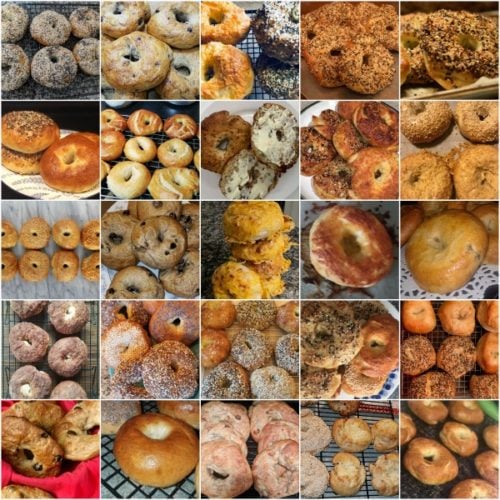
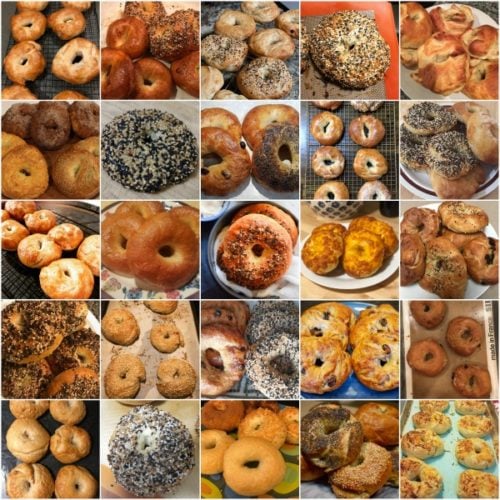
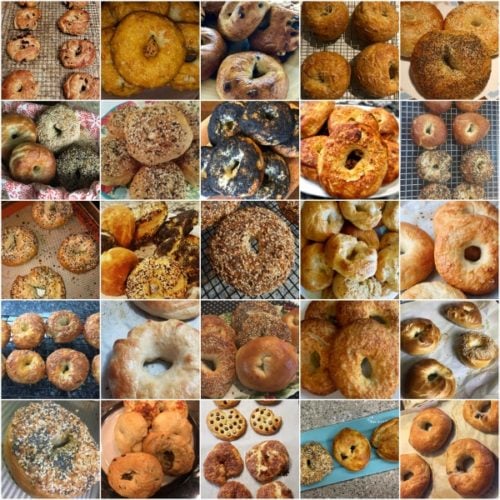
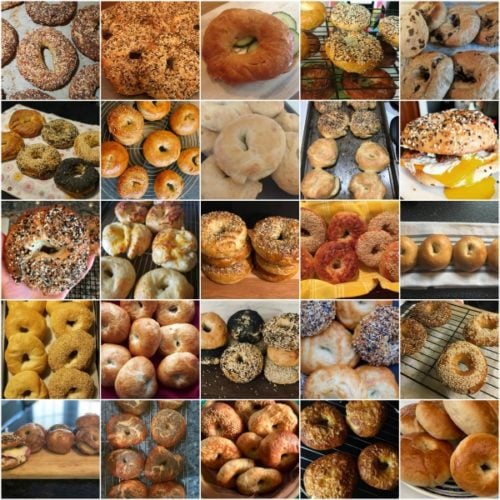
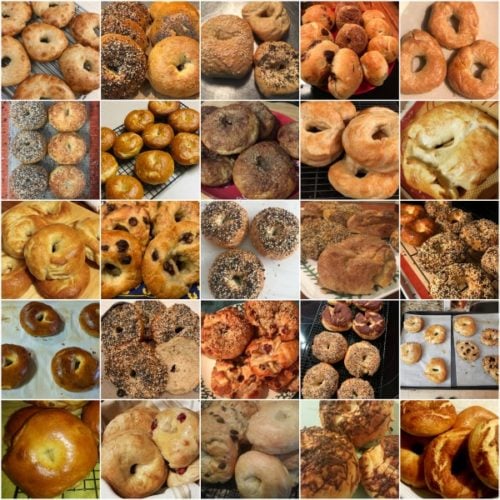
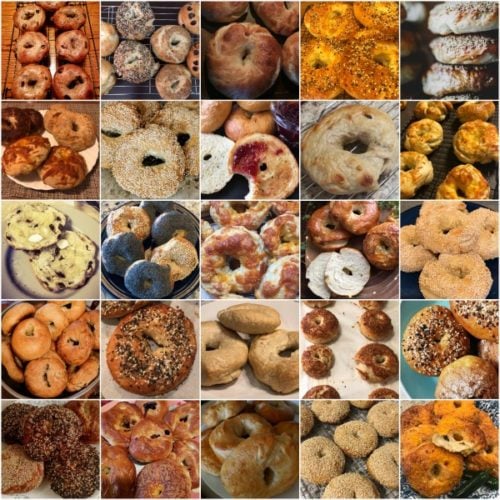
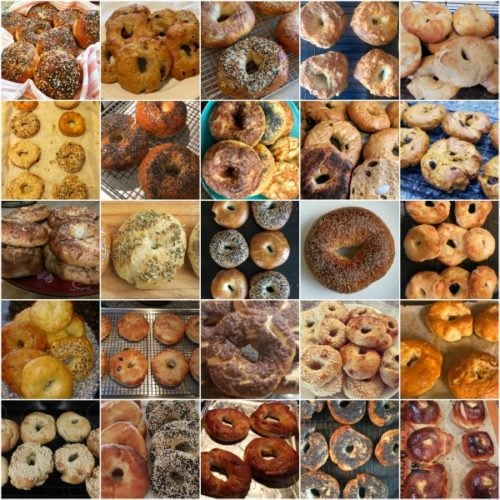
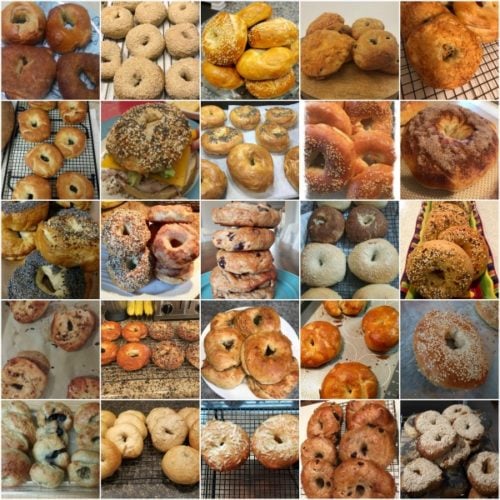





















This is by far my favourite recipe for bagels! Your instructions are bang on and the flavour is supreme! I have even used sour dough discard with less yeast. I looked up the mix for an everything topping and I am 100% satisfied with the turn out. Thank you for sharing your wonderful recipe! 5/5
How long are these good for once baked? I looked through your recipe and FAQ but didn’t see anything.
Hi Jess, Cover leftover bagels tightly and store at room temperature for a few days or in the refrigerator for up to 1 week.
I loved this recipe! I always thought baking bagels was a feat because of their unusual cooking method, but this recipe made it super simple to understand and my bagels turned out beautiful and golden brown. They were nice and doughy on the inside just like the store bagels, but I get to say I made it! This recipe is so great to have as a nice base because you can add anything into it like seasonings!
Great recipe, but what are the nutrition facts?
Hi Megan, We don’t usually include nutrition information as it can vary between different brands of the same ingredients. Plus, many recipes have ingredient substitutions or optional ingredients listed. However, there are many handy online calculators where you can plug in and customize your exact ingredients/brands. Readers have found this one especially helpful: https://www.verywellfit.com/recipe-nutrition-analyzer-4157076
Best bagel recipe, they turn out perfectly chewy
Third time making it. Never buy again.FANTASTIC
I’ve used this recipe two times now and each time, they get better. Thank you for creating something easy, that tastes great, and helps build baking confidence.
We’re so glad you love this bagel recipe, Wendy!
I love this recipe! Made them last night and they are e better than a deli bagel! I did have one question though. My sister has celiacs and I was wondering, can I replace the bread flour for gluten free bread flour and still keep everything else the same? If not do you have a gluten free version available? Thank you!
Hi Alexa, we haven’t tested a gluten free version of these bagels, but let us know if you try anything!
This is an incredible recipe. I have made it with bread flour and all-purpose. There was no difference. I also added many different flavouring ingredients such as blueberries, chocolate chips, strawberries and everything bagel seasoning. The berries definitely require some extra flour added to the dough because it became stickier, but the extra flour didn’t seem to affect the bagel. I also used a baking soda bath and only bathed them for about 20 seconds or so each side. Truly an awesome recipe!
Thanks foe the recipe, any suggestions for a vegan substitution of the egg wash?
Hi Sheyla, instead of egg wash, you can brush them with some nondairy milk before baking.
These bagels are chewy and delicious. I substituted honey with molasses in the water. I also kneaded dough by hand for 12 minutes.
I have a naïve question. I am in the middle of making this recipe and was wondering if the water with the dissolved honey can be stored in the refrigerator and reused later. BTW – they are in the oven and look yummy and can’t wait to try them. This is my first time making bagels.
Hi David, we haven’t tried it, but imagine that *should* work okay for a few days. Let us know if you do give it a try. Hope you enjoyed the bagels!
I loved bagels! But I’m wondering if I can add a sponge dough to your recipe without changing anything. I would appreciate your advice.
Hi Doreen, we haven’t tested the recipe that way, so are unsure of exactly what to recommend. If you try it, please let us know how it goes!
I would love to have a good egg bagel recipe. Any thoughts?
Hi Peggy, we haven’t tried an egg bagel version yet, but let us know if you test anything!
Delicious! Fluffy on the inside and perfectly crispy on the outside! I’m not a baker by any means and this recipe was easy to follow!
Can molasses be used to replace barley malt syrup? Also, the recipe i used for sourdough discard bagels, added baking soda with sugar to boiling water. Your thoughts on need or use of baking soda.
Thanks.
Hi Tammy, we haven’t tested molasses in the water bath, but some readers have commented that they have used it with success. We use baking soda to boil homemade pretzels, but it’s not necessary here.
I can´t get good bagels where I live, so this recipe has come to the rescue many times. I’ve made everything and cheese bagels on repeat. The recipe always turns out.
I wounder if I can use a food processor instead of the mixer?
Hi Kevin, We do not recommend using a food processor to mix this dough as it will quickly overwork the dough. Instead, if you don’t have a stand mixer you can simply use a large mixing bowl and mix the dough with a wooden spoon or silicone spatula and knead the dough by hand.
I was wondering if it’s possible to halve the recipe?
Hi Anne-Marie, halving can be a bit tricky with yeasted recipes, so we recommend making a full batch and freezing any leftovers.
The four cups of flour leveled off instruction is way off. I always use my scale and measured off exactly 480 g at 120 g per cup. It was very obvious to me that what was spinning around my KitchenAid mixer was something slightly thicker than pancake batter and I must have gradually added 10 to 15 teaspoons before I found the sweet spot. It’s one thing to dust a little flower gradually into The mixing Bowl but as I said this was way off. I always found measuring in grams to be the best course of action as there is no chance for everyone’s own way of leveling off or potentially packing the cup down with more than a cup even though it’s been leveled off. 120 g per cup though can only be 120 g. The end product was great. I have made bagels many times before.
If you’re used to baking with measuring cups and not weight, the 4 cups was actually spot on. Having spent a life time baking and also living in the US, I find both was easy to master. That being said, a good set of measuring cups is just as important as an accurate scale.
Are you outside of the US? Could it be that the flour you’re using is a different consistency? Because American flour is not the same as e.g. European flour.
Best bagels ever! These beat any we’ve bought in a bakery before! Saving this for future bagels on repeat 🙂
This has been my go-to bagel recipe since lockdown! One question: The bagels that go right into the oven after boiling seem to come out just a little better than the ones that have to wait on the counter. Is there anything I can do about that?
Hi Shawn, we’re so glad you enjoy the bagels! If you want, you could wait until the first batch is done, then boil and bake the second batch so they’re not sitting on the counter.
Such a great and easy recipe! I did overnight fridge rise and they’re perfect and chewy. Thank you!
Hi! Planning on making the dough tonight and cooking the bagels in the morning.
When you let it rise in the fridge overnight? Did you leave it at room temp first or right into the fridge?
Hi Ashley, right into the fridge for a slow rise.
Hi Sally & team! I have made this recipe several times and I am a huge fan. Do you have a recommendation or a recipe for making a pumpkin bagel?
Hi Anna, so glad you love these bagels! We wish we could help, but we haven’t tried making pumpkin bagels. You’d likely need to *slightly* adjust the liquid and add more flour if you add some pumpkin puree. Let us know if you test anything!
Whoops, I didn’t see that Charlie had asked this a few days ago! Great minds think alike! Thanks so much for your response!
I make these all the time and they are amazing! Have you crafted a recipe for a pumpkin or pumpkin spice bagel?
Hi Charlie, we wish we could help, but we haven’t tried making pumpkin bagels. You’d likely need to *slightly* adjust the liquid and add more flour if you add some pumpkin puree. Let us know if you test anything!
I love this recipe too and I just tried that! I cut the water to 240 ml (about 1 cup), added 3/4 cup pumpkin puree and 1 tsp of pumpkin pie spice. I did have to add some extra flour, I would guess about 1/4 – 1/2 cup extra flour. After trying them, I think next time I will add 2 tsp of pumpkin pie spice for a bit more flavor. I also added the cinnamon crunch topping from her cinnamon variation of the bagels and I think that added the perfect sweetness to the top of the bagel!